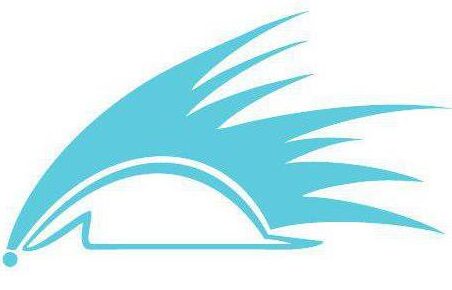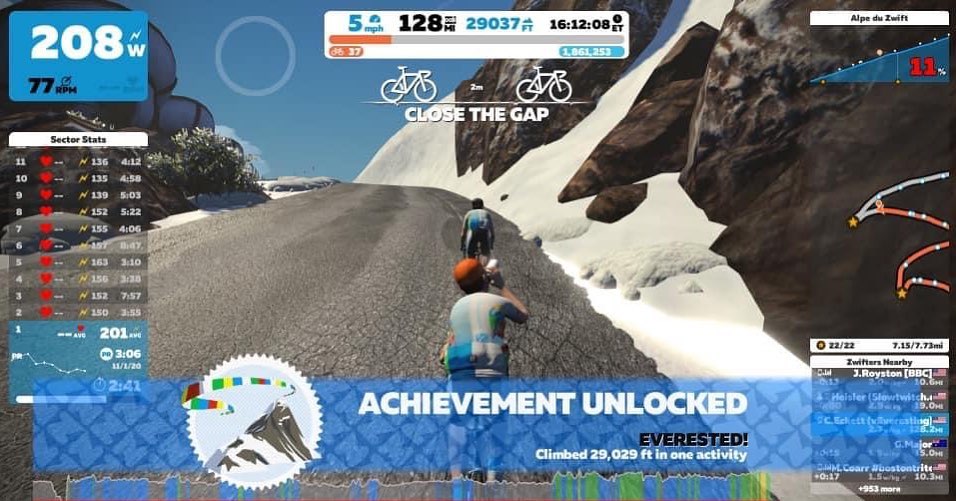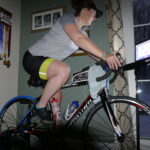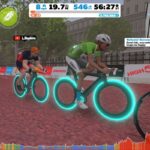It’s been a couple of weeks now since my cycling Everesting attempt, so I’ve finally decided to sit down and write some of my thoughts on the experience. Apologies for the long article ahead.
2020 has been a strange year to say the least. For endurance athletes, with races canceled all year long, it’s been tough to find the motivation or the “why” to continue training hard. In my case, having a coach helps a lot. Missed workouts that turn red in Training Peaks are enough of a deterrent for me that I get it done. But it still felt fairly pointless. Many cyclists and triathletes have turned to indoor trainer cycling on the online cycling app Zwift, which has really boomed during COVID, thanks in part to the numerous e-races and virtual challenges offered.
After building up a lot of bike fitness through various Zwift events over the summer, one of our Sonic Endurance team members had the suggestion that we should try a virtual Everesting. Everesting is where you choose a hill, then ride up and down it times until the total elevation gain matches that of Mt Everest, 8848m or 29029ft. There’s no time limit. It’s an endurance challenge. You can take breaks in the middle if you need to. The only hard-and-fast rule is that you can’t sleep during the ride, and thus take multiple days to do it. You have to do it all in one “day” or waking period. When you do it virtually on a smart trainer with a simulated climb, it’s known as virtual Everesting, or vEveresting.
After 2 minutes research, I jumped at the idea, and with the help of coach Ryan Heisler, I started building towards an attempt in the October/November timeframe. As the date got nearer, other teammates decided against it or weren’t ready for it yet. So this was going to have to be a solo attempt. I decided to do the ride on Alpe du Zwift, which is Zwift’s replica of the famed Alpe d’Huez climb in France, with its 21 switchbacks, 3400 ft of climbing and 8.5% average grade. One trip up the Alpe is a big effort. I was going to have to do it 8.5 times.
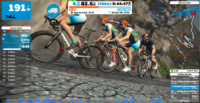
I also decided to make the ride meaningful, and use it as a fundraiser for the Lupus Foundation of America. Thanks to the support of some very generous friends and teammates, I was able to raise over $500 for the foundation in just a week of fundraising. I’ve had autoimmune diseases all my adult life, and have learnt to get by with them, but a few years ago they morphed into Lupus, which has been the worst of the bunch. My Lupus has been under reasonably good control recently, but it takes a cocktail of drugs to do so, and the side effects of the drugs are almost as bad as the disease. One side effect of the steroids I’m on is weakened bone density – osteopenia, bordering on osteoporosis. In August this year, during the first outdoor group ride I’d done since the outbreak of COVID, I hit some road debris and went over the handlebars at 18mph. For most people, that would have just meant a bunch of road rash and some painful showers for the next week. But in my case I also managed to break several bones in my body due to their fragility. I spent the next 2 days in the hospital. My thoracic spine had multiple wedge compression fractures, including some over 50% compression. The doctors said no more outdoor cycling until I was not only healed, but also until my bone density could be restored to a healthy level. No worries – I was mostly focused on indoor cycling in the near term. Fortunately, I was actually able to get back on the indoor bike pain free just a few days later, with some slight modifications to my cycling position to keep the spine well aligned.
I had selected Saturday, November 14, 2020 for the Everesting attempt. I told very few people about it until a week before, in case something happened that would cause me to have to cancel or delay the attempt. But by the Sunday before, with my last long training ride complete and only the taper ahead of me, things looked good and I started posting about the attempt on social media, and advertising the fundraising. Then the Lupus took one final crack at me in the taper week. I had an annual drug infusion scheduled for that Monday to improve my bone density. I haven’t had any issues with this infusion in the past, but this time I had a bad reaction to it a couple of days afterwards. Flu-like symptoms that knocked me out for about 24 hours. Fortunately, the symptoms were gone by Thursday night and didn’t seem to have taken anything out of me. The last tune-up ride on Friday morning felt OK, so the attempt was on.
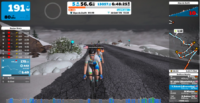
I started at 6am on Saturday. By my estimates, if all went well, the ride would take me between 14 and 18 hours. Many have asked how I could sit on a bike trainer that long. Certainly, if this had truly been a solo ride, I agree it would have been mentally unbearable. But I was fortunate to have many friends and teammates who were willing to jump into Zwift and ride a climb or two with me. I certainly couldn’t have done it without this fantastic support. So a huge thanks goes out to Ken Clark, Peter Lee, Paul Ryan, Rob Piperno, Kelly Burns, and particularly coach Ryan Heisler. I don’t think I was riding alone for more than about 1 of the 8.5 climbs. Thanks also to other friends and teammates who sent words of encouragement or Face timed me during the ride.
My biggest issue during training had been chafing. Any ride longer than 3 or 4 hours had led to bad chafing, which I was worried would be more of a limiter than my fitness or leg strength. Once again, my support network came to the rescue. Ryan suggested changing cycling bibs after each climb, and Chris Petron suggested trying the anti-chafing product Chamois Butt’r Eurostyle, which contains soothing menthol not included in the regular Chamois Butt’r I’d been using. Both suggestions were great. Zero chafing problems throughout the Everesting ride. Yay!
So, how did it go? For the first 7 hours and 4 climbs up the Alpe, it was going fine. But then things turned ugly. My legs turned to jelly on the 5th climb, a classic bonk. And with so much of the ride left to go, I didn’t see any way I’d be able to finish. This isn’t like a marathon or Ironman, where if things go bad some distance out from the finish on the run, you can always walk and still finish. When you’re climbing 10+% grades on a bike, there’s a minimum number of watts needed just to keep the bike moving forward. I was ready to call it a day. Fortunately, after a conversation with Ryan towards the top of that 5th climb, and a review of my situation including what fuel and hydration I’d been able to take in, he realized I was getting enough calories and electrolytes, but not enough overall hydration. He somehow convinced me to keep going and suggested adding a bottle of water for every bottle of electrolytes. To “catch up”, I initially took double that. And I was surprised at how quickly things turned around. I was soon able to get back to nearly the same watts I’d been doing on the earlier climbs. From there, it was just a matter of keeping it steady, grinding it out, taking a few breaks here and there, and getting it done with the support of teammates. The last climb was my strongest in the 2nd half of the ride. I finished the Everesting challenge, with Ryan pulling me up the last 1.5 climbs, at 10:50pm Saturday evening. Nearly 17 hours from start to finish, including breaks.
The other amazing and unexpected thing that happened in the ride was the fantastic Zwift community support. Tradition dictates that while you’re making an Everesting attempt, you add a “vEveresting” tag to your Zwift screen name. This drew a vast number of thumbs-up Ride Ons and encouraging in-game comments from total strangers. There was also a surprising number of others who were making vEveresting attempts that same day. Particularly early on, a lot of Europeans, who were much further along in their attempts due to the time difference. One guy from Switzerland actually finished his vEveresting ride, then jumped back into the game a couple of times later to check up on me and offer some encouragement through my bad patch. Amazing!
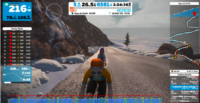
So in the end, was it worth it? Absolutely. I’ll never do it again. For me, it was a once in a lifetime thing, that physically I think was as hard as an Ironman. But unlike an Ironman, where you have to suffer in solitude, the support and encouragement I got during the ride made a world of difference, and ultimately had me finish stronger than I have in any Ironman. I’ll happily ride in support of anyone else crazy enough to try this, because the support was everything.
For the data geeks, here’s some numbers, including the extra descent back down the Alpe after finishing the Everesting.
Duration: 17 hours 3 minutes, including 16 hours 23 minutes moving time
Elevation: 29,157 ft
Distance: 136 miles
Average power: 135 W
Average speed: 8.0 mph
Calories burned: 7710
Fuel and hydration: 11 bottles of Infinit custom endurance mix, 5 Picky Bars, 3 PB&J sandwiches, 5 bottles of water
Number of Ride Ons: 148
Tips for a successful vEveresting:
- Support during the ride, including communication with a coach or someone else without “Everesting Brain” who can figure out what to change when things goes bad
- Enough calories, electrolytes and fluids
- Frequent bib changes – need to stay dry!
- Chamois Butt’r Eurostyle
- Lots of climbing training and leg strength work so you can spend long periods of time out of the saddle during the ride
